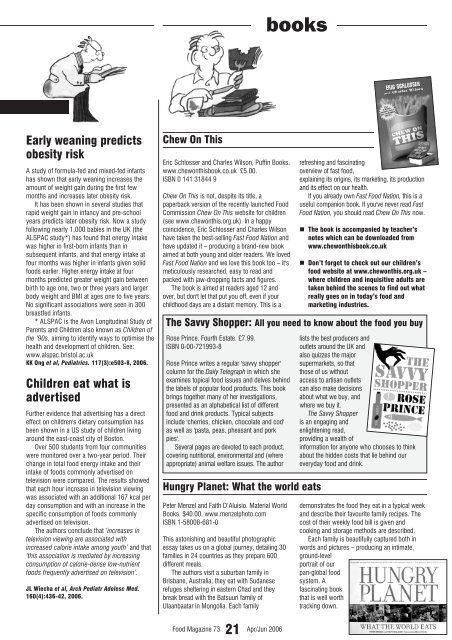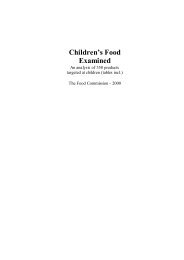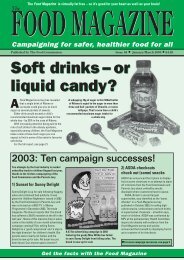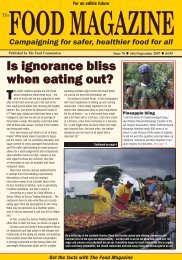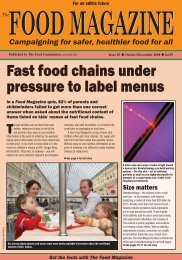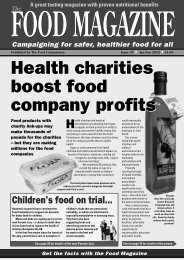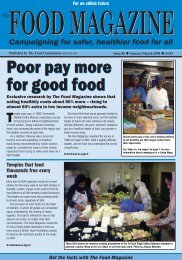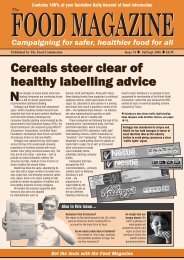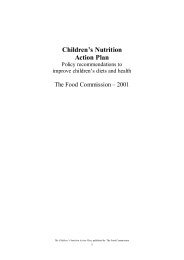Campaigning for safer, healthier food for all - The Food Commission
Campaigning for safer, healthier food for all - The Food Commission
Campaigning for safer, healthier food for all - The Food Commission
You also want an ePaper? Increase the reach of your titles
YUMPU automatically turns print PDFs into web optimized ePapers that Google loves.
ooks<br />
Early weaning predicts<br />
obesity risk<br />
A study of <strong>for</strong>mula-fed and mixed-fed infants<br />
has shown that early weaning increases the<br />
amount of weight gain during the first few<br />
months and increases later obesity risk.<br />
It has been shown in several studies that<br />
rapid weight gain in infancy and pre-school<br />
years predicts later obesity risk. Now a study<br />
following nearly 1,000 babies in the UK (the<br />
ALSPAC study*) has found that energy intake<br />
was higher in first-born infants than in<br />
subsequent infants, and that energy intake at<br />
four months was higher in infants given solid<br />
<strong>food</strong>s earlier. Higher energy intake at four<br />
months predicted greater weight gain between<br />
birth to age one, two or three years and larger<br />
body weight and BMI at ages one to five years.<br />
No significant associations were seen in 300<br />
breastfed infants.<br />
* ALSPAC is the Avon Longitudinal Study of<br />
Parents and Children also known as Children of<br />
the ’90s, aiming to identify ways to optimise the<br />
health and development of children. See:<br />
www.alspac.bristol.ac.uk<br />
KK Ong et al, Pediatrics. 117(3):e503-8, 2006.<br />
Children eat what is<br />
advertised<br />
Further evidence that advertising has a direct<br />
effect on children's dietary consumption has<br />
been shown in a US study of children living<br />
around the east-coast city of Boston.<br />
Over 500 students from four communities<br />
were monitored over a two-year period. <strong>The</strong>ir<br />
change in total <strong>food</strong> energy intake and their<br />
intake of <strong>food</strong>s commonly advertised on<br />
television were compared. <strong>The</strong> results showed<br />
that each hour increase in television viewing<br />
was associated with an additional 167 kcal per<br />
day consumption and with an increase in the<br />
specific consumption of <strong>food</strong>s commonly<br />
advertised on television.<br />
<strong>The</strong> authors conclude that ‘increases in<br />
television viewing are associated with<br />
increased calorie intake among youth’ and that<br />
‘this association is mediated by increasing<br />
consumption of calorie-dense low-nutrient<br />
<strong>food</strong>s frequently advertised on television’.<br />
JL Wiecha et al, Arch Pediatr Adolesc Med.<br />
160(4):436-42, 2006.<br />
Chew On This<br />
Eric Schlosser and Charles Wilson, Puffin Books.<br />
www.chewonthisbook.co.uk £5.00.<br />
ISBN 0 141 31844 9<br />
Chew On This is not, despite its title, a<br />
paperback version of the recently launched <strong>Food</strong><br />
<strong>Commission</strong> Chew On This website <strong>for</strong> children<br />
(see www.chewonthis.org.uk). In a happy<br />
coincidence, Eric Schlosser and Charles Wilson<br />
have taken the best-selling Fast <strong>Food</strong> Nation and<br />
have updated it – producing a brand-new book<br />
aimed at both young and older readers. We loved<br />
Fast <strong>Food</strong> Nation and we love this book too – it's<br />
meticulously researched, easy to read and<br />
packed with jaw-dropping facts and figures.<br />
<strong>The</strong> book is aimed at readers aged 12 and<br />
over, but don't let that put you off, even if your<br />
childhood days are a distant memory. This is a<br />
Rose Prince. Fourth Estate. £7.99.<br />
ISBN 0-00-721993-8<br />
Rose Prince writes a regular 'savvy shopper'<br />
column <strong>for</strong> the Daily Telegraph in which she<br />
examines topical <strong>food</strong> issues and delves behind<br />
the labels of popular <strong>food</strong> products. This book<br />
brings together many of her investigations,<br />
presented as an alphabetical list of different<br />
<strong>food</strong> and drink products. Typical subjects<br />
include 'cherries, chicken, chocolate and cod'<br />
as well as 'pasta, peas, pheasant and pork<br />
pies'.<br />
Several pages are devoted to each product,<br />
covering nutritional, environmental and (where<br />
appropriate) animal welfare issues. <strong>The</strong> author<br />
refreshing and fascinating<br />
overview of fast <strong>food</strong>,<br />
explaining its origins, its marketing, its production<br />
and its effect on our health.<br />
If you already own Fast <strong>Food</strong> Nation, this is a<br />
useful companion book. If you've never read Fast<br />
<strong>Food</strong> Nation, you should read Chew On This now.<br />
<strong>The</strong> book is accompanied by teacher’s<br />
notes which can be downloaded from<br />
www.chewonthisbook.co.uk<br />
Don’t <strong>for</strong>get to check out our children’s<br />
<strong>food</strong> website at www.chewonthis.org.uk –<br />
where children and inquisitive adults are<br />
taken behind the scenes to find out what<br />
re<strong>all</strong>y goes on in today’s <strong>food</strong> and<br />
marketing industries.<br />
<strong>The</strong> Savvy Shopper: All you need to know about the <strong>food</strong> you buy<br />
Hungry Planet: What the world eats<br />
Peter Menzel and Faith D’Aluisio. Material World<br />
Books. $40.00. www.menzelphoto.com<br />
ISBN 1-58008-681-0<br />
This astonishing and beautiful photographic<br />
essay takes us on a global journey, detailing 30<br />
families in 24 countries as they prepare 600<br />
different meals.<br />
<strong>The</strong> authors visit a suburban family in<br />
Brisbane, Australia; they eat with Sudanese<br />
refuges sheltering in eastern Chad and they<br />
break bread with the Batsuuri family of<br />
Ulaanbaatar in Mongolia. Each family<br />
lists the best producers and<br />
outlets around the UK and<br />
also quizzes the major<br />
supermarkets, so that<br />
those of us without<br />
access to artisan outlets<br />
can also make decisions<br />
about what we buy, and<br />
where we buy it.<br />
<strong>The</strong> Savvy Shopper<br />
is an engaging and<br />
enlightening read,<br />
providing a wealth of<br />
in<strong>for</strong>mation <strong>for</strong> anyone who chooses to think<br />
about the hidden costs that lie behind our<br />
everyday <strong>food</strong> and drink.<br />
demonstrates the <strong>food</strong> they eat in a typical week<br />
and describe their favourite family recipes. <strong>The</strong><br />
cost of their weekly <strong>food</strong> bill is given and<br />
cooking and storage methods are described.<br />
Each family is beautifully captured both in<br />
words and pictures – producing an intimate,<br />
ground-level<br />
portrait of our<br />
pan-global <strong>food</strong><br />
system. A<br />
fascinating book<br />
that is well worth<br />
tracking down.<br />
<strong>Food</strong> Magazine 73 21<br />
Apr/Jun 2006


